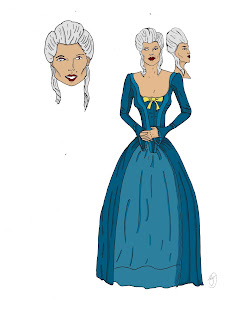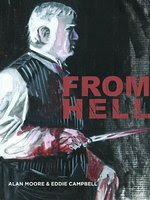Why are my female character's face so square?
It has been pointed out that when I design my characters especially the females, their jaw line is too square. So this section I will talk about why that is the case and how & if there are ways to improve this.
Here is a section of characters faces I have designed from past and current projects, so you can see how I currently draw them. This will give this section context.
As you can see from the three examples all of them have quite angular jaw lines. The first design is too angular and looks more masculine compared to the others as even though their jaw line isn’t rounded they are still quite feminine in appearance.
Why do my female characters have such jaw lines? Well that is because of the reference models I use. When I am designing characters I research different faces, so when it come to the drawing I can create a wide variety of designs. The one constant is the images I reference they all have a square or oval shaped face.
These are some of the woman I reference to illustrate my point.
As you can see all these women have strong square like jaw-lines. I tend you use these images as stating points and that is why my characters have jaw-lines more angular than expected.
Another reason I use theses face types is that I find them, the easiest to draw from the 6 basic face types.
Now that I have explained why my characters look the way they do, I will now address the improvements needed to them.
The most obvious is that even though the references have square-eques jaw-lines they are not as pronounced as I have drawn them. When I do my redesigns I will take a lighter approach to the jaw and give them a slight rounder edge.
Other ways I could improve is if I look at other face types, this will broaden my capabilities of drawing female faces.
There are 6 face types and I think that every time I design a female character one of the face types will be of the other face shapes. The six face shapes are as follows:
Oval: Forehead may be slightly wider than the chin, and the length of the face is about one and a half times the width.
Round: Prominent, rounded cheeks with equal width and length of the face.
Square: Prominent jaw and square chin, with forehead and jawline roughly the same width.
Oblong: Often confused for the oval face, though an oblong face will have a longer shape that is not as wide as oval — often with a narrow chin.
Heart: Wider forehead and cheekbones with a narrow jawline and chin.
Diamond: Narrow forehead and jawline with cheekbones at the widest point of the face.
I hope this has addressed any critique my designs have faced and with the points I have made I will make my improvements.
Evidence
Here is a section of characters faces I have designed from past and current projects, so you can see how I currently draw them. This will give this section context.
As you can see from the three examples all of them have quite angular jaw lines. The first design is too angular and looks more masculine compared to the others as even though their jaw line isn’t rounded they are still quite feminine in appearance.
Why?
Why do my female characters have such jaw lines? Well that is because of the reference models I use. When I am designing characters I research different faces, so when it come to the drawing I can create a wide variety of designs. The one constant is the images I reference they all have a square or oval shaped face.
These are some of the woman I reference to illustrate my point.
As you can see all these women have strong square like jaw-lines. I tend you use these images as stating points and that is why my characters have jaw-lines more angular than expected.
Another reason I use theses face types is that I find them, the easiest to draw from the 6 basic face types.
Improvements
Now that I have explained why my characters look the way they do, I will now address the improvements needed to them.
The most obvious is that even though the references have square-eques jaw-lines they are not as pronounced as I have drawn them. When I do my redesigns I will take a lighter approach to the jaw and give them a slight rounder edge.
Other ways I could improve is if I look at other face types, this will broaden my capabilities of drawing female faces.
There are 6 face types and I think that every time I design a female character one of the face types will be of the other face shapes. The six face shapes are as follows:
Oval: Forehead may be slightly wider than the chin, and the length of the face is about one and a half times the width.
Round: Prominent, rounded cheeks with equal width and length of the face.
Square: Prominent jaw and square chin, with forehead and jawline roughly the same width.
Oblong: Often confused for the oval face, though an oblong face will have a longer shape that is not as wide as oval — often with a narrow chin.
Heart: Wider forehead and cheekbones with a narrow jawline and chin.
Diamond: Narrow forehead and jawline with cheekbones at the widest point of the face.
I hope this has addressed any critique my designs have faced and with the points I have made I will make my improvements.







Having read the entirety of this blog post, I have a few points to make myself.
ReplyDeleteFirst off, none of the women in the pictures you've shown as "reference" have jawlines anywhere near what you've drawn.
A little life drawing tip is to use a ruler or your pencil to measure the incline of angles, it helps, and in your case it would help your female characters from looking like they belong on an episode of Drag Race.
Secondly, I'd like to mention that maybe you should consider taking a life drawing class, it really helps hammer in the importance of proportion throughout the body, and shows how female and male bodies differ. For example, males are the ones with broader shoulders and narrower hips, not females. Females have wide hips, or in the very least hips that at least somewhat match the breadth of their shoulders. Using your above images as reference for my point, two out of three of them have broader shoulders than they do hips, it throws these women off balance and again, makes them look masculine. Looking at a real model helps improve accuracy in drawing more than any flat image ever can. But that's just a suggestion.
Thanks for your comment, I totally get what you mean and that is why I made this post. I do have life drawing lessons and they do help. The images I have shown in this post are the extreme examples as I am aware they are not in proportion, those details will be addressed in a separate post. I will be posting my new designs for the first soon that will address the proportion issue. I showed the images as my 'reference' as even though I do life drawing I use these as a guide when I'm not as I am practicing to be able to draw completely without reference. Thank for your suggestions I'll take them onboard.
Delete